|
For several years now, transnational food companies have understood that their main growth markets are in the South. To increase their profits they need to “dig into the pyramid”, as one company puts it, meaning they need to develop and sell products targeted at the millions of the world’s poor. These people generally eat food from their own farms or informal markets selling locally-produced foods, and in which many of them earn their livelihood.
To get at these potential consumers, food companies are infiltrating, inundating and taking over traditional food distribution channels and replacing local foods with cheap, processed junk foods, often with the direct support of governments. Free trade and investment agreements have been critical to their success. The case of Mexico provides a stark and horrific picture of the consequences for people.
Transnational food companies understand that their main growth markets today are in the global South. They are aggressively targeting the diets – and markets – of the world’s poorest people. (Photo: Thierry Collins)
Malnutrition, food insecurity and “diabesity” in Mexico
In Mexico, poverty, hunger, obesity and disease go hand in hand. Mexicans are not only struggling to afford enough to eat; the food they eat is making them ill.
In 2012, Mexico’s National Institute for Public Health released the results of a national survey of food security and nutrition.1 The study assessed Mexicans’ food security against what is known as the Latin American and Caribbean Food Security Scale (ELCSA).2 The results made it clear that these problems were far worse than had been acknowledged, as seen in the graphs and table below.
 Click to enlarge Click to enlarge
The ENSANUT report found that between 1988 and 2012, the proportion of overweight women between the ages of 20 and 49 increased from 25% to 35.5% and the number of obese women in this age group increased from 9.5% to 37.5%.4 A staggering 29% of Mexican children between the ages of 5 and 11 were found to be overweight, as were 35% of the youngsters between 11 and 19, while one in ten school age children suffer from anaemia.
The level of diabetes is equally troubling. The Mexican Diabetes Federation says there are 6.5 million to 10 million people who suffer from diabetes in Mexico, with around two million of them unaware that they have the disease. This means that more than 7% of the Mexican population has diabetes. The incidence rises to 21% for people between the ages of 65 and 74. Diabetes is now the third most common cause of death in Mexico, directly or indirectly. In 2012, Mexico ranked sixth in the world for diabetes deaths. The specialists predict that there will be 11.9 million Mexicans with diabetes by 2025”.5
Obesity and diabetes function together, interacting so strongly that a new name has emerged: “diabesity”.

“Diabetes linked with obesity is a very serious health problem in Mexico and our country paid an amount equivalent to 2.97 billion pesos [$228 million] in 2003 and 8.8 billion pesos [$670 million] in 2010 for treatments related to diabetes. This is a 290% increase in just seven years,” says Alexandro Calvillo, the director of El Poder del Consumidor, a national consumer protection group. Meanwhile, the Ministry of Health puts the cost of obesity treatments at 80 billion pesos [more or less $6 billion] and could rise to 150 billion pesos by 2017.6
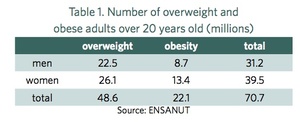 Click to enlarge Click to enlarge
All these data cannot be explained away by the popular explanations of “a change in the pattern of food consumption due to expanded possibilities and options”. The reality is that certain foods have been imposed on the country, while foods produced and nurtured by people according to their cultures and to their real needs are becoming more and more scarce.
The NAFTA effect
The various free trade agreements that Mexico has signed over the past two decades have had a profound impact on the country’s food system. After his mission to Mexico in 2012, the then Special Rapporteur on the Right to Food, Olivier De Schutter, concluded: “The trade policies currently in place favour greater reliance on heavily processed and refined foods with a long shelf life rather than on the consumption of fresh and more perishable foods, particularly fruit and vegetables… The overweight and obesity emergency that Mexico is facing could have been avoided, or largely mitigated, if the health concerns linked to shifting diets had been integrated into the design of those policies.”7
The investment liberalisation aspects of these agreements are as much a source of the problem as the trade aspects.
According to Corinna Hawkes, NAFTA instruments are indeed fostering crucial aspects of the kind of economic integration that the powerful partners in the agreements want: “food trade and global production sourcing; the direct investment in food processing and a change in the retail structure (notably the advent of supermarkets and convenience stores); the emergence of global agribusiness and transnational food companies; deepening the global food advertising and promotion”.8 NAFTA instruments also provide for the development of global rules and institutions “that govern the production, trade, distribution and marketing of food”, but also “buying companies products and services”, something that create “incentives for TFC to grow through global vertical integration and sourcing”.9
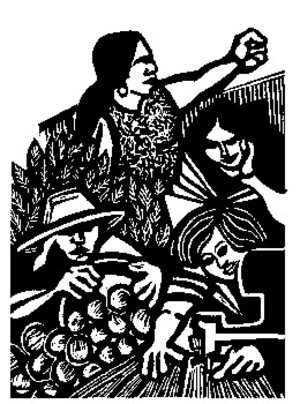 To deal effectively with hunger and malnutrition, Mexico must focus on its small farmers and peasants. (Drawing: Rini Templeton) Under its investment provisions, NAFTA required Mexico to provide equal treatment to domestic and foreign investors, with the elimination of rules preventing foreign investors from owning more than 49% of a company. It also prohibited the application of certain “performance requirements” such as minimum amounts of domestic content in production and increased rights for foreign investors to retain profits and returns from initial investments. New laws that might change the status of foreign investments once established were also heavily discouraged by the agreement’s notorious investor state resolution chapter.
NAFTA triggered an immediate upsurge of direct investment from the US into the Mexican food processing industry. In 1999 “US companies invested $5.3 billion in Mexico’s food processing industry [in 1999], a 25-fold increase from $210 million in 1987, and more than double the $2.3 billion in the year before NAFTA,” says researcher Corinna Hawkes. Between 1999 and 2004, “approximately two thirds of the $6.4 billion FDI in Mexican agricultural and food industries was from the United States. Nearly three-quarters of FDI was into the production of processed foods, and it stimulated considerable growth of the sector. Between 1995 and 2003, sales of processed foods expanded by 5–10% per year in Mexico.”10
Sales of baked goods, dairy products, snack and junk foods rose faster than any other category, especially soft drinks. Servings of 8 oz. soft drinks rose from 275 per person per year in 1992 to 487 servings per person per year in 2002.11
Mexico is now one of the ten biggest producers of processed food in the world, and all of the largest transnational processed food corporations, such as PepsiCo, Nestlé, Unilever and Danone, have expanded their major Mexican operations.12
These companies are making big money. Total sales of processed foods in Mexico was $124 billion in 2012, and processed food corporations pocketed $28.33 billion in profits from these sales, 46.6% [nearly $9 billion] more than in Brazil, Latin America’s largest economy.13
The Economist says Mexico is a haven for food processing companies not only because of low costs (which amount to a saving of 14.1% compared to the US).14 But other competitive advantages, such as the “network of trade agreements that permit access to big markets such as the European Union and the US with tariff preferences,” mean that, in spite of the global economic crisis, “the sales of retail business establishments have grown steadily in the last three years.”15 All in all, Mexico has signed 12 free trade agreements with 44 nations, 28 bilateral investment treaties and 9 agreements of economic cooperation.16
A token tax
Last year, the Mexican government, under pressure to address the growing health crisis, passed a bill to apply an 8% tax on high-calorie packaged foods, including peanut butter and sweetened breakfast cereals. It also passed a special tax of one peso (8 US cents) per litre on soft drinks.17 The government portrayed its actions as a tough measure to curb sales of junk foods. But without complementary actions to encourage healthy alternative options to the processed foods that have flooded the Mexican market and the country’s poorest neighbourhoods in particular, the tax seems to be merely a grab for a share of the lucrative junk food trade that the government’s own policies have facilitated. The only difference is that Mexican consumers will have to pay more for the foods that are killing them.
As if to drive this point home, immediately after the tax was passed, PepsiCo, one of the leading producers of junk foods in the country announced an investment of $5 billion in its Mexico operations, while Nestlé pledged a $1 billion investment.18 Contrary to what one could expect, the investment is not applied to publicity or marketing only, but to “innovation, brand building, infrastructure, and new links with agriculture and public relations and “projects” with communities.19
Domination of the sales point
One of the reasons why the big food corporations are so confident of their capacity to increase sales despite the new tax, is the high level of control they exercise over food distribution. This, says Corinna Hawkes, was NAFTA’s “second effect” on the Mexican food system20: an “explosive” growth of chain supermarkets, discounters and convenience stores, “from less than 700 to 3,850 in 1997 [alone], and 5,729 in 2004”.21 The success of Wal-Mart – now the “nation’s leading retailer” – and other supermarkets, is surpassed only by the growth of the “convenience store chains” (selling “a limited number of convenience items 24 hours a day”).
In these emerging patterns of retail distribution, huge supermarkets are, of course, important because they concentrate goods, but a crucial aim is to replace the corner shops (the “tienditas”), aggressively taking over former independent territories of trade.
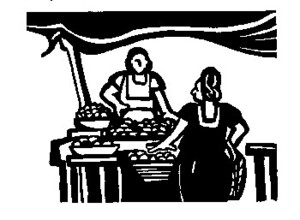 Street vendor (Drawing: Rini Templeton) The food corporations began by colonising the existing, dominant food distribution networks of small-scale vendors, known as tiendas (the corner stores). There are some 400,000 tiendas, estanquillos or misceláneas premises in Mexico, stores smaller than 10 square meters which carry a limited variety of products and are equipped with a limited amount of refrigeration and inventory.22
“Tiendas have proved critical to the spread of comidas chatarra [junk food]; they are the means by which transnationals and domestic food companies sell and promote their foods to poorer populations in small towns and communities,” said Corinna Hawkes in 2006. “Over 90% of all Coca Cola and PepsiCo sales [by the early 2000s] were from tiendas”.23
Food corporations swamped the tienda distribution channels with products to encourage consumption and lower transportation costs (by linking the delivery of various goods produced by the same company to each and every selected destination). PepsiCo, for example, distributes not only soft drinks to tiendas but also its Sonric line of candies, multiple varieties of its Sabritas potato chips and other related snacks and. Each product line has enormous sales because of what the industry calls “the absolute domination of the sales point”. Availability has become a crucial factor in buying and consuming. People will eat what they have at hand, and the available goods are almost only processed foods.
We need to understand that tiendas – and convenience stores even more – do not sell only what is generally accepted as junk food. These places also sell a narrow range of packaged, bottled or canned processed food, making them the only stuff available.
The tiendas are, however, quickly being replaced by corporate retailers that offer the processed food companies even greater opportunities for sales and profits.
By 2012, retail chains had displaced tiendas as Mexico’s main source of food sales, with 35% of the country’s market, and tiendas holding on to 30% and open street markets having 25%.24 According to the Mexican Chamber of Commerce, five tiendas close for every convenience store that opens.25
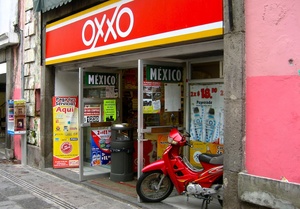 Oxxo (owned by Coca-cola subsidiary Femsa) opens an average of 3 new stores per day – it will open its 14 thousandth store in Mexico sometime in 2015. Oxxo (owned by Coca-cola subsidiary Femsa) opens an average of 3 new stores per day – it will open its 14 thousandth store in Mexico sometime in 2015.
For example Oxxo (owned by Coca-cola subsidiary Femsa) tripled its stores to 3,500 between 1999 and 2004.26 In July 2012, Oxxo was opening its ten thousandth facility, and is aiming to open its 14 thousandth store sometime during 2015. This means opening a thousand stores per year, an average of 3 stores per day.27 Oxxo did 19 billion pesos of trade (more than 1 billion dollars) during the first trimester of 2012.28 It received 72.40 billion pesos (more than 5 billion dollars) during the third trimester of 2014, 13.2% more than a year before.29
Oxxo’s sales growth was ten times that of Soriana, Mexico’s second largest supermarket chain.30 During 2014 Oxxo surpassed Soriana in retail sales, becoming to be the second largest retailer in the country behind Walmart, leaving the tiendas, and the families who operate them, in the dust.31 Now, with Soriana taking over one of the largest supermarket chains in México, Comercial Mexicana, the experts guess that Soriana will regain second place.32
A sweet solution to hunger
The food processing companies at the centre of Mexico’s health emergency spend enormous amounts of money on public relations to gloss over the problems their foods and marketing campaigns generate. Advertisements across Mexico associate these companies with family values, sustainability, charity, good health and quality jobs.33 The companies are particularly interested in being visibly involved in government campaigns, and Mexico’s governments, strangely enough, embrace their participation.
In April, 2013, the Ministry of Social Development (Sedesol) signed agreements with PepsiCo and Nestlé to involve them in the government’s “National Crusade Against Hunger”34
Under the agreement, Sedesol provides “federal subsidies for the execution of projects in selected priority zones” while the corporations claim that they “will guarantee food security through nutritional products for the populations that are in poverty and extreme poverty”.
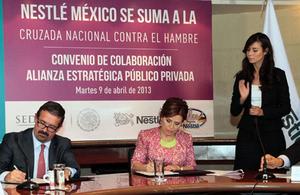 The government is partnering with Nestlé to send a small army of Mexican women out to promote nutri- tion – using Nestlé products, of course. The government is partnering with Nestlé to send a small army of Mexican women out to promote nutri- tion – using Nestlé products, of course.
PepsiCo pledged to develop two fortified oat based products under its Quaker brand and to build a Global Baking Category Innovation Centre in Monterrey, México.35 Nestlé promised a new coffee processing plant in Guerrero and the expansion of several projects, including one focused on “women entrepreneurs”, called Mi Dulce Negocio (My Sweet Business), which the company also runs in Venezuela and Bolivia. Under this project, Nestlé plans to train 1,500 Mexican women to make sweet but “nutritious” desserts containing Nestlé products, and to supply these women with kits so that they can go out and train another ten women each. In total, a “small army” of 15,000 Mexican women will be mobilised in “priority zones” across the country to promote the Nestlé way of nourishing children, with the financial support of Mexico’s Ministry of Social Development.
Backing rich producers and paying off the poor
Mexico is a country where 78.5 million people now suffer from some form of food insecurity. Yet there are more or less 48.6 million Mexican adults who are overweight or obese – about 7 out of 10 adult Mexicans – and 22.1 million adults who suffer from obesity alone. “These people will be ill for an average of 18.5 years during their lifetimes”. And the problem is increasing across all income levels, although fastest amongst the poorest 20%.36 The consequences are significant – escalating rates of type 2 diabetes, cardiovascular disease and different forms of cancer. Mexico’s Crusade Against Hunger will not solve the problem. No campaign against hunger can be effective with only a few demonstrative pilot projects scattered around a huge country like Mexico. The Crusade Against Hunger targets only 7.8 million people – barely a tenth of the number of Mexicans the ENSANUT study shows are suffering from food insecurity and only slightly higher than the 5.1 million children under 5 years old suffering from nutrition problems. (See tables 1, 2 and 3.) 37 The project’s priority zones are not even in the areas where there is extreme hunger or poverty as defined by the Consejo Nacional de Evaluación de la Política de Desarrollo Social (Coneval).38
A far more complex and radical approach is required than the sugar tax and hunger crusade that the government is advancing, one that takes on the empire of processed food, whose tentacles already reach into almost every urban space and are fast spreading through the countryside.
 Free trade agreements like NAFTA have shifted Mexican diets away from fresh fruit and vegetables towards heavily processed and refined foods, with catastrophic effects on the health and development of children. (Photo: Actitud)
The terrible truth is that “between 1999 and 2006, consumption of sugar-sweetened beverages doubled and that, today, about 10% of Mexicans’ total energy intake comes from these beverages”. And they badly need that energy. Taxing these soft drinks is only “a soft-policy instrument”, says the UN’s former Special Rapporteur on the Right to Food Olivier De Schutter, because “it locates the problem of overweight and obesity in consumers’ behaviour, when in fact this problem stems from the food system as a whole.”39
For De Schutter, a programme that deal effectively with hunger and malnutrition has to focus on Mexico’s small farmers and peasants. They constitute a substantial percentage of the country’s poor, and they are the ones that can best supply both rural and urban populations with nutritious foods.40
“Most agricultural programmes fail to target the poor: taken as a whole, agricultural public expenditures are highly regressive,” says De Schutter. He points out that “while more than 95% of expenditures by the Mexican government on social programmes under its Special Concurrent Program for Sustainable Development (PES) target the poor” less than 8% of expenditures on agricultural programmes are similarly targeted”. Moreover, in 2005, the six poorest states received only 7% of total agricultural public expenditures despite the fact that they were home to 55% of the extreme poor.
“In a country made up by 80% of farmers with less than 5 hectares, it would appear desirable to consider allocating more resources to supporting small-scale farmers in disadvantaged areas, as the programmes in place currently fail to address rural poverty effectively,” says De Schutter.41
After hearing hundreds of testimonies from around the country, the international jury of the Peoples Permanent Tribunal, held in México city in November 2013, came to a similar conclusion.
Mexico could recover its self-sufficiency in food if there was official support for peasant agriculture backed with amounts comparable to the support granted to the big corporations. One of the necessary conditions for this would be the reconstitution of the instruments of support for the countryside that were disabled by NAFTA. The loss of food sovereignty directly caused by this array of policies has, as its main component, induced changes in the Mexican diet, with catastrophic effects.
Mexico has one of the highest rates of obesity, diabetes and high blood pressure in the world. It is the world leader in consumption per head of cola drinks and one of the highest consuming countries for “junk food”. The consumption of maize products in Mexico has also started to decline for the first time in history.
While Via Campesina argues that the most important component of food sovereignty is autonomous food production and that the people themselves should define what they eat, in Mexico governments, corporations and the media have jointly promoted a costly campaign to boost consumer habits that, under the cover of modernisation, have been systematically destroying the food preferences of Mexicans.42
Nothing less than a complete overhaul of Mexico’s disastrous trade and investment liberalisation polices and a new orientation towards support for the country’s small farmers is necessary to effectively deal with its national food and health crisis.
Notes
2 ELCSA, the Escala Latinoamericana y Caribeña de Seguridad Alimentaria, measures consumption of calories required for an active or healthy life.This scale divides into food insecurity into three categories: Mild food insecurity means the absence of diverse and healthy food; medium food insecurity denotes households facing chronic scarcity of food, where children do not get enough to eat and adults must sometimes skip one or more meals in the day; severe food insecurity refers to families where one adult routinely goes through the whole day without eating and children go to sleep hungry or even spend a whole day without food. See Melgar-Quiñonez, H, “Informe sobre la aplicación pasada y presente de la Escala Latinoamericana y Caribeña de Seguridad Alimentaria (ELCSA) y otras herramientas similares en América del Norte, Centroamérica y El Caribe”, FAO/Ohio State University, 2010 and Encuesta Nacional de Salud y Nutrición (Ensanut) 2012: “La distribución de la Inseguridad Alimentaria en México)”, Instituto Nacional de Salud Pública, 21 de noviembre, 2012..
4 Julio Boltvinik, op.cit.
7 Report of the Special Rapporteur on the Right to Food, Olivier De Schutter, addendum, Mission to Mexico, Human Rights Council, Nineteenth session, Agenda item 3, 17 January 2012, A/HRC/19/59/Add.2
9 Vertical integration is “when a company brings together the entire process of producing, distributing and selling a particular food under its control by buying and contracting other companies and services worldwide, thus reducing the transaction costs associated with having different suppliers”. In global sourcing a company searches for inputs, production sites and outputs where costs are lower and regulatory, political and social regimes favourable. This enables TFCs to cut costs and helps safeguard against the uncertainty of commodity production and product sales. Corinna Hawkes, op.cit.
20 Corinna Hawkes, op.cit.
23 Corinna Hawkes, op.cit
24 The last 10%, sometimes not accounted for, is held by hotels, restaurants and cafés. See Agencia Andaluza de Promoción Exterior, “Nota sectorial alimentaria en México”, May 2012, PDF.
25 USDA, Foreign Agriculture Service, Gain Report, Mexico’s Retail Food Sector, op.cit. Quoted in Corinna Hawkes, op.cit.
34 (A new programme which the government claims is addressing the hunger from the bottom up but which rests on the intervention by large corporations (such as Pepsico and Nestlé, prominent figures like FAO’s Graziano da Silva, former Brazilian president Lula Da Silva, and billionaires like Bill Gates and México’s own Carlos Slim.)
36 Olivier De Schutter, op.cit.
37 Julio Boltvinik, op.cit.
39 Olivier De Schutter, op.cit.
40 The conflict in Mexico, between high fructose corn syrup (HFCS) and sugar is an issue that we need to address with deeper argumentation and research carried out over a long period. The evidence so far points to the fact that HFCS is driving the import of industrial maize to Mexico, possibly including GM maize, or even to its production, changing more and more the traditional goal of agriculture from producing foods to producing commodities. See “Rompen récord, importaciones mexicanas de maiz”, El economista, 7 January 2014; Alicia Loyola Campos, “Azúcar-fructosa: el sabor amargo de un comercio desigual”, February 2003; Nydia Egremy, “La amarga guerra de la fructosa”, Fortuna, negocios y finanzas
41 Olivier De Schutter, op.cit.
|